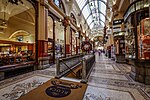Melbourne ( (listen) MEL-bərn) (Boonwurrung: Naarm) is the capital and most-populous city of the Australian state of Victoria, and the second-most populous city in both Australia and Oceania. Its name generally refers to a 9,993 km2 (3,858 sq mi) metropolitan area known as Greater Melbourne, comprising an urban agglomeration of 31 local municipalities, although the name is also used specifically for the local municipality of City of Melbourne based around its central business area. The city occupies much of the northern and eastern coastlines of Port Phillip Bay and spreads into the Mornington Peninsula and the hinterlands towards the Yarra Valley and the Dandenong and Macedon Ranges. It has a population over 5-million (19% of the population of Australia, as per 2020), mostly residing to the east side of the city centre, and its inhabitants are commonly referred to as "Melburnians".The area of Melbourne has been home to Aboriginal peoples for over 40,000 years and serves as an important meeting place for local Kulin nation clans. Of the five peoples of the Kulin nation, the traditional owners of the land encompassing Melbourne are the Boonwurrung and the Wurundjeri peoples. The name Naarm is commonly used by the broader Aboriginal community to refer to the city, stemming from the traditional Boonwurrung name for Port Phillip Bay.A short-lived penal settlement was built at Port Phillip, then part of the British colony of New South Wales, in 1803, but it was not until 1835, with the arrival of free settlers from Van Diemen's Land (modern-day Tasmania), that Melbourne was founded. It was incorporated as a Crown settlement in 1837, and named after the then British Prime Minister, William Lamb, 2nd Viscount Melbourne. In 1851, four years after Queen Victoria declared it a city, Melbourne became the capital of the new colony of Victoria. During the 1850s Victorian gold rush, the city entered a lengthy boom period that, by the late 1880s, had transformed it into one of the world's largest and wealthiest metropolises. After the federation of Australia in 1901, it served as the interim seat of government of the new nation until Canberra became the permanent capital in 1927. Today, it is a leading financial centre in the Asia-Pacific region and ranks 23rd globally in the 2021 Global Financial Centres Index.Melbourne is home to many of Australia's best-known landmarks, such as the Melbourne Cricket Ground, the National Gallery of Victoria and the World Heritage-listed Royal Exhibition Building. Noted for its cultural heritage, the city gave rise to Australian rules football, Australian impressionism and Australian cinema, and has more recently been recognised as a UNESCO City of Literature and a global centre for street art, live music and theatre. It hosts major annual international events, such as the Australian Grand Prix and the Australian Open, and also hosted the 1956 Summer Olympics and the 2006 Commonwealth Games, and will host the 2026 Commonwealth Games, along with a number of regional areas of Victoria. It was host to the 1880 World's Fair. Melbourne consistently ranked as the world's most liveable city for much of the 2010s.Melbourne Airport, also known as the Tullamarine Airport, is the second-busiest airport in Australia, and the Port of Melbourne is the nation's busiest seaport. Its main metropolitan rail terminus is Flinders Street station and its main regional rail and road coach terminus is Southern Cross station. It also has Australia's most extensive freeway network and the largest urban tram network in the world.











